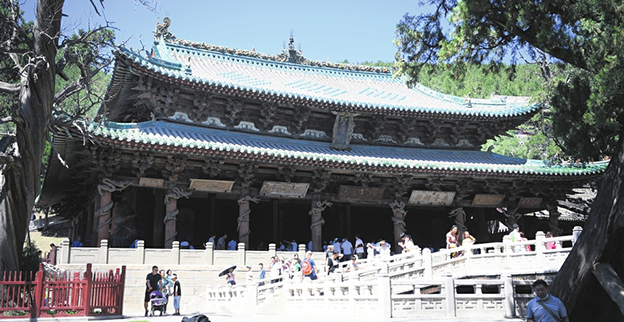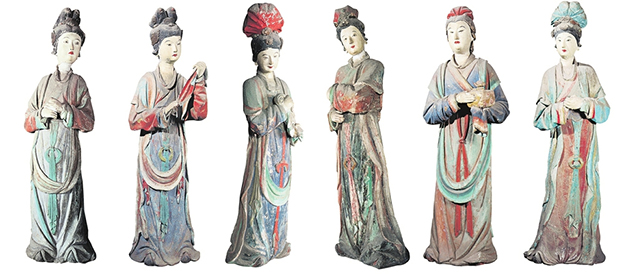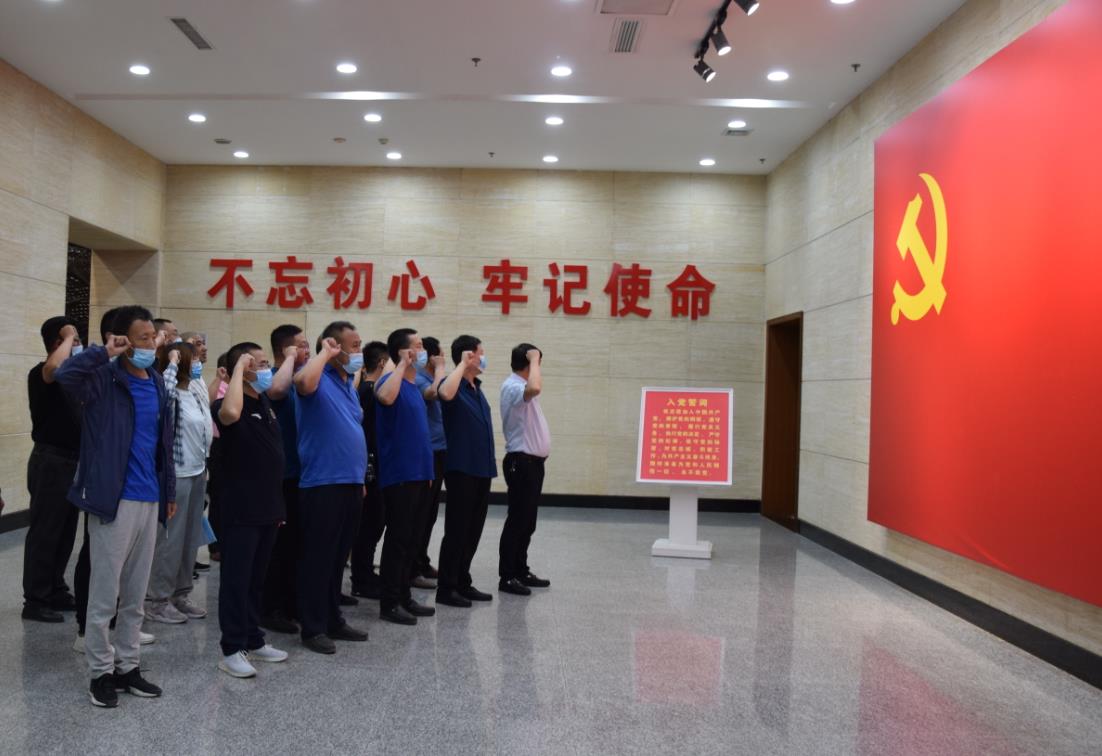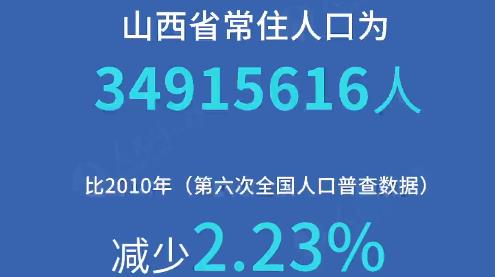
The Hall of the Sacred Mother and the bridge over the Yuzhao Pond are among the top sites in Jinci. HU XUGUANG / FOR CHINA DAILY

The statues of maids in the Hall of the Sacred Mother are sculpted in a vivid and natural style. QIU PING / FOR CHINA DAILY
When famed Tang Dynasty (618-907) poet Li Bai visited Jinci, one of the top attractions in Taiyuan, he wrote a poem with one line going like this: "The flowing water of Jinci is like blue jade."
The immortal line has helped Jinci win a perpetual reputation among tourists, who regard it as a must-see attraction in Taiyuan, the capital city of today's Shanxi province, for many centuries.
Jinci used to be the ancestral temple of kings of the Jin state during the Western Zhou Dynasty (c. 11th century-771 BC) and the Spring and Autumn Period (770-476 BC).
Legend has it that Ji Song became the second monarch of the Western Zhou Dynasty when he was young. He once played with his younger brother, Shuyu, sending him a piece of soil as a gift.
The playful game was recorded by his ministers, who required the monarch to give his brother a certain territory as a fiefdom, appointing him the king of it because the soil represented the land of a state.
Ji Song honored his promise and Shuyu became the first king of the state that was called Tang at that time.
Shuyu made a great contribution to the development of the fiefdom, by leading locals to improve agriculture through building irrigation projects.
When Xiefu, the son of Shuyu, succeeded his father to become the second king, he changed the fiefdom's name to Jin.
Xiefu built the Jinci-which means the ancestral temple of the Jin state-to memorialize his father.
The ancestral temple was renovated and expanded during the following millennia, becoming the largest ancient building complex in Taiyuan.
With structures built in the Song (960-1279), Yuan (1271-1368), Ming (1368-1644) and Qing (1644-1911) dynasties still kept intact, the Jinci temple remains a museum of ancient Chinese architecture.
The temple is an ideal place for tourists to explore the millennia-long history of the region and study ancient Chinese architecture.
Wu Huijuan is an experienced local tour guide who can show the many historical and cultural values of the site to tourists.
When guiding a tourist group from Guangdong province on Aug 22, Wu mentioned the "three top treasures" of the temple-the Hall of Sacrifice, the bridge over the Yuzhao Pond and the Hall of Sacred Mother.
"The Hall of Sacrifice, a Song Dynasty building, is epitome of ancient Chinese architecture. The wooden structure was put together with mortise and tenon joints, without using a single nail," Wu said.
She added the bridge over the Yuzhao Pond is the only cross-shaped bridge in China.
When showing tourists the Hall of Sacred Mother, the main hall of the temple, she reminded them of the vivid statues and exquisite decorations.
"The statues of maids in the hall deserve careful study.
"As the hall was built in the Song Dynasty, we can have a glimpse of the lifestyle of the period judging from the maids' garments and utensils they hold," Wu said.
Wu said the maid statues are among the "three additional wonders" of Jinci, together with the Zhou Dynasty cypress trees and the Never Aging Spring.
She said the two cypress trees standing beside the Hall of Sacred Mother are said to have been planted in the Western Zhou Dynasty.
"The age of the trees is not a legend. Carbon-14 dating proved that they are 2,600 to 2,990 years old,"Wu said, adding that the trees still show great vitality with lush, evergreen leaves.
For calligraphy enthusiasts, a stone stele with inscriptions written by Tang Dynasty emperor Li Shimin is another highlight.
Li was the second emperor of the Tang Dynasty and was a native of Taiyuan.
Before rising to fame, he and his father Li Yuan-the first emperor of the Tang Dynasty-always visited the temple and asked the deities to help unite the nation and build a prosperous dynasty.
Li Shimin visited the temple 28 years after he became the second emperor of the Tang Dynasty.
When recalling his promise made at the temple and the decades of war and peace, Li wrote an 1,000-word essay. As Li himself was one of the top calligraphers of his times, the essay inscribed on the stone has become a treasure for many calligraphy enthusiasts in the centuries to follow.
Wu Ran, a calligrapher from Northeast China's Jilin province, visited Jinci recently. He said the trip was a worthwhile experience as it offered him an opportunity to see the works of this renowned calligrapher and one of the greatest emperors in Chinese history.
"Li was a fan of Wang Xizhi, the greatest calligrapher of China. Li's calligraphic works, with the similar charm of Wang's, are inspirational for calligraphy lovers in China," Wu said.
Guo Yanjie contributed to this story.
By YUAN SHENGGAO
 山西路桥:党建引领 建好“四好农村路”山西路桥建设集团党委扎实开展“党建质量提升年”,实施“六大工程”,立足“十四五”高质量、高速度、高效益发展的战略基点,全面提高党建质量和党建引领发展水平,为打造“国内一流的交通基础设施投资、建设、施工现代化企业集团”提供坚强政治保障。
山西路桥:党建引领 建好“四好农村路”山西路桥建设集团党委扎实开展“党建质量提升年”,实施“六大工程”,立足“十四五”高质量、高速度、高效益发展的战略基点,全面提高党建质量和党建引领发展水平,为打造“国内一流的交通基础设施投资、建设、施工现代化企业集团”提供坚强政治保障。
 常住人口3491万 山西人口普查数据"出炉"山西省统计局向社会通报山西省第七次全国人口普查主要数据。数据显示,山西省常住人口为34915616人,比2010年(第六次全国人口普查数据,下同)减少2.23%,年平均减少0.23%。山西省常住人口总量减少,主要受人口流动变化等因素影响。
常住人口3491万 山西人口普查数据"出炉"山西省统计局向社会通报山西省第七次全国人口普查主要数据。数据显示,山西省常住人口为34915616人,比2010年(第六次全国人口普查数据,下同)减少2.23%,年平均减少0.23%。山西省常住人口总量减少,主要受人口流动变化等因素影响。